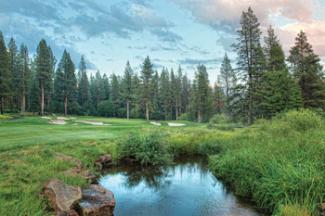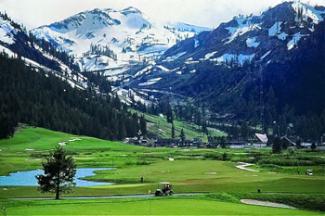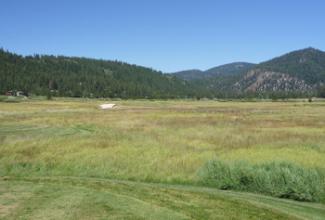Featured Golf News
Golf a Standout in Historic Truckee
The mountainous area near the northwestern edge of Lake Tahoe is famous for its peerless beauty, exclusivity and friendliness.

Tahoe Donner Golf Course
The environs around the town of Truckee are also historic thanks to two events separated by 113 years that left an indelible mark on the region: the misery endured by the Donner Party in the winter of 1846-47 in a Sierra Nevada mountain pass, and the 1960 Winter Olympic Games in the sleepy, one-horse town of Squaw Valley.
The ill-fated Donner Party (sometimes called the Donner-Reed Party) was a group of American pioneers who set out for California from Springfield, Ill., in April 1846 in a wagon train. Delayed by a series of mishaps, they spent the winter of 1846-47 snowbound in the Sierra Nevada.
The journey west usually took four to six months. But the Donner Party was slowed when it followed a new route called Hastings Cutoff, which crossed Utah's Wasatch Mountains and the Great Salt Lake Desert. The rugged terrain and difficulties encountered while traveling along the Humboldt River in present-day Nevada resulted in the loss of many cattle and wagons, creating rifts within the group.
By the beginning of November 1846 the immigrants reached the Sierra Nevada, where they became trapped by an early, heavy snowfall near Truckee (now Donner) Lake, high in the mountains. Their food supplies ran low, and in mid-December some of the group set out on foot to get help.
Rescuers from California attempted to reach the group, but the first relief party did not arrive until the middle of February 1847, almost four months after the wagon train became trapped. By then, some of the travelers resorted to cannibalism to survive, eating those who had succumbed to starvation and sickness. Of the 87 original party members, 48 survived and reached California.

Donner Party Memorial Rests on 22-foot-high
Stone Pedestal- Height of
the Snow in the Winter of 1846-47
Accuracy a Must at Tahoe Donner GC
In the years since those events, the region has become one of the most desirable in the nation for both alpine sports and excellent golf.
In the summer of 2013 I played two courses, Tahoe Donner Golf Course and the Championship Course at Squaw Creek, each of which enjoys a direct connection to the area's heritage. That aspect, combined with their aesthetics and pleasing nature, makes this region one of the most visited in the western U.S. for year-round recreation.
Tahoe Donner GC is located about two miles north of the massive memorial erected in tribute to the Donner Party and the spirit of the American West. The layout is situated on 200 acres and features plenty of elevation changes amid granite outcroppings. The course is renowned for having some of the Tahoe Region's best putting surfaces.

Pine Forests Complicate Par at Tahoe Donner GC
Opened in 1976, the front nine was built and designed by Roy Williams and then expanded to 18 holes and refined by famed architect, Billy Bell, Jr. The first director of golf at Tahoe Donner was Craig Stadler, former PGA and current Champions Tour player. Photographs in the lodge capture one of the facility's most memorable days when Jack Nicklaus, Tom Watson and Stadler competed in a golf exhibition.
The track - which plays at a par of 72 and stretches 7,002 yards from its back set of four tees - underwent a major renovation in 2006 and soon garnered a Golf Digest nomination for "Best Remodeled Course in America."
With a course set amid the natural splendor of forest and streams, golfers can expect a considerable number of doglegs and multi-tiered, rolling greens. The layout wanders through pine forests interlaced with meandering creeks and streams. From the peaks of its rolling hills visitors can enjoy panoramic views of the Truckee Valley.

18th Hole at Tahoe Donner GC
Tahoe Donner GC has seven par-4s of 410 yards or more. But the need for tee-power is mitigated somewhat by the elevation (about 7,200 feet above sea level). Yet accuracy is a must to keep shots in play on these pine-lined corridors.
The challenge begins at the opener - an incredibly tight, 452-yard par-4 that is arguably the most difficult starting hole in the Sierra Nevada. The ascending route requires a drive placed along the left side of a tight fairway to provide a decent angle into the green.
Perhaps the most demanding stretch at Tahoe Donner is its midsection. The 468-yard par-4 eighth is ranked the No. 3 hole by handicap (after the first). It's followed by the 574-yard par-5 ninth and 421-yard par-4 10th.
Players can take a chance at driving the green at the 321-yard par-4 13th, but the prudent play is to find the fairway for a safer wedge approach.
After putting out on the 17th, golfers take a 300-yard walk - or ride - through a forest before reaching the closer, which may be the best test at Tahoe Donner. Starting off a towering tee and dropping to the deepest green complex on the course, the hole measures 417 yards from the tips and provides a spectacular end to the round. The putting surface is the largest on the course and surrounded by five bunkers fronted by Trout Creek.
Although Tahoe Donner GC shares a name and a location with the ill-fated pioneering party, this course is all about feast, not famine, catering a heaping helping of all the assets that are good about golf in the region.

Championship Course at Resort at Squaw Creek
Squaw Creek Boasts a Winning Combination of Mountains & Wetlands
The Championship Course at Squaw Creek is the main spring and summer draw at the Resort at Squaw Creek, which occupies the site of most of the events from the 1960 Winter Olympics.
The Olympics were held February 18-28. Squaw Valley was an undeveloped resort in 1955, so from 1956-60 the entire infrastructure and all the venues were built at a cost of more than $80 million.
The Olympic Village was designed to be intimate, allowing spectators and competitors to walk to nearly all the sporting venues. Squaw Valley hosted athletes from 30 nations who competed in four sports and 27 events; women's speed skating and the biathlon made their Olympic debuts here.

16th Green at the Resort at Squaw Creek
Located at the base of Squaw Valley USA at an elevation of 6,200 feet, the par-71 layout measures 6,931 yards from the back gold tees. When the golf course was designed in the mid-1980s by Robert Trent Jones, Jr., it was heralded as one of the industry's top environmental success stories. Jones melded the mountain surroundings (and a handful of holes that run next to and through massive rocks) with the natural wetlands formed in the lowlands between the ridges.
The course is maintained without the use of chemical pesticides, a boon for the native wildflowers, birds and animals that find sanctuary here. Crossing mountain and meadow terrain, the layout is made difficulty by its narrow fairways - not from trees so much as bordering wetlands containing tall grasses.
Squaw Creek begins with three holes in the forest and alongside the mountain. Most notable among the openers are the 242-yard par-3 third and 554-yard par-5 fifth, which places tremendous demands on accuracy. After that, the course moves down into meadowlands, resulting in target golf.
The 386-yard par-4 sixth has a ridge running through the middle of the green that will make putting difficult if one isn't on the correct section. At just 365 yards, the eighth continues the trend of shorter par-4s. But the meadow surrounding all sides of the hole is a factor on both the drive and second shot.
The start of the back nine is a solid 385-yard par-4 guarded by a lake right and trees left. The 10th green bears a large bunker at its left, but those who overcompensate to the right may bounce off a slope and into a hazard.
The 16th is perhaps the most visually intimidating hole here, with its green and surrounds an island in the middle of wetlands and high grass. At 204 yards, this par-3 isn't the longest one-shotter but is the toughest.
For serious golfers, this narrow Lake Tahoe-area course is best played when the golfer is on his or her game. Precision, not distance, is the key. The four tees allow for flexibility, and the magnificent area - surrounded by six awe-inspiring Sierra Nevada peaks - is worth the trip all by itself.
For more information about these courses visit http://www.tahoedonner.com/golf and http://www.squawcreek.com/lake-tahoe-golf.php.
Steve Habel is a freelance writer contributing Cybergolf news stories, features, equipment and book reviews and personality profiles from his base in Austin, Texas. He also works as an associate editor for Horns Illustrated magazine, a publication focusing on University of Texas sports, and is a contributing writer for Texas Golf Insider, Golf Oklahoma magazine, Tri-State Golfer and ATX Man magazine. Habel's blog (www.shotoverthegreen.blogspot.com) features news on golf and chronicles his many travels, including playing almost 1,000 golf courses since 2008. Habel is a member of the Golf Writers Association of America and the Texas Golf Writers Association.
Story Options
 |
Print this Story |
